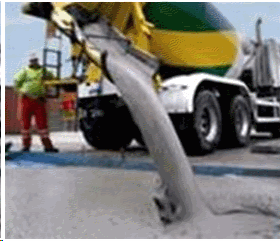Main menu
You are here
Self-Placing Concrete
Self-Placing Concrete

The Need
Certain concrete pours have areas where the congestion of reinforcing bars make placement of concrete almost impossible. Using conventional placing and vibration techniques, the resulting concrete can have considerable honeycombing due to the development of voids. Not only is this undesirable but the labor cost of placing using traditional methods is high. Methods need to be developed to reduce labor costs, shorten construction time and produce a better finished product.
The Technology
Self-placing concrete is a possible solution to the problem. Also known as self-compactable concrete, self-consolidating concrete, flowable concrete, and non-vibration concrete. These concretes eliminate the need for vibration in a placement process where the reinforcement makes proper vibration difficult or impossible. Perhaps, as important as the lack of needed vibration, is that the density is obtained without segregation.
Self-placing concrete is obtained by the use of various admixtures. The particular admixture for a mix is usually developed by individual companies where Japanese firms are currently leading the way. Generally, a conventional concrete mix is used with the addition of a water reducing agent. The water cement ratio is kept the same. This combination results in a "flowable" concrete with usually high compressive strengths.

The Benefits
The costs of self-placing concrete may be slightly higher but the payback of reduced labor required for placement and improved construction schedule must be considered to determine a benefit. Additional benefits include the ability to use conventional batching plants and ready-mix transit trucks which eliminates the need to invest in a new plant.
Applications
SCC has a lot of advantages mainly related to slim elements and in situations where the space between reinforcement bares is very limited.
Main applications of SCC are:
- Architectural Concrete (Exposed Concrete)
- Columns
- Residential structures
- Beams
- Civil Projects
- Tanks
- Pumped Concrete
- Footers
- And More!
Arguments
SCC has an increasing trend in the construction business and there are advantages for the different people in the construction process. What should be considered before using SCC:
Pro´s:
- Labor savings - Less on-site labor forces needed (often one person less for pouring)
- Faster placing of big structural elements – less risk related to un-proper placing
- No vibration – less risk of not well compacted areas
- Usage when there are dense reinforcement bares
- Easier placement over any distance or constraints
- Accelerated project schedules
- Improve the working environment for employees (Reduced noise, safety, and environmental concerns)
- Reducing wear and tear of equipment
- Fast placement without vibration or mechanical consolidation
- Extremely good finished surface quality—SCC can take on nearly a mirror-like surface and can produce concrete with very fine detail
Con´s:
- More expensive
- Increased stiffness of formwork needed due to increased side pressure
- Pouring must be carried out carefully – not to much material at once
- Very well planned and managed site – continuous placing in order to avoid working joints
- Good coordination with RMC supplier – continuous dispatching needed
- Risks to manage:
- Segregation
- Sedimentation
- Stagnation of flowability

The cost/benefit analysis of SCC balances the increased cost of the concrete against substantial labor savings and aesthetic benefits (smooth surface finish). The benefits of SCC are apparent at many levels of the construction process, from production, to placement, to quality of the finished product. Modification of design, production and construction practices may be required to show the full impact of SCC benefits. Due to generally higher strengths resulting from the high powder content needed for SCC, the economic benefit has been most obvious where high strengths were already needed for design reasons. With SCC very high early stripping strength will be achieve that leads to a quicker turnaround on forms. The smooth surface finish will minimize or eliminate the need for time-consuming treatments and cosmetic repairs.
While many projects can be converted to SCC mixes during the construction phase, it is best to consider its use as early as possible. SCC construction requires teamwork. The owner and designer, the contractor, formwork supplier, and finisher, the producer and material suppliers must all work together to produce a quality SCC project that realizes the economic benefits for all concerned.
History
In the early 1980s, Japan faced a lack of skilled workers who could construct durable concrete structures. Professor Hajime Okamura (University of Tokyo) advocated the use of SCC as a solution to this problem. SCC technology in Japan was based on using conventional superplasticizers to create highly fluid concrete, while also using viscosity-modifying agents (VMA) which increase plastic viscosity thus preventing segregation up to a level of fluidity that would normally cause segregation. When the technology reached Europe in the 1990s, their approach was to add powders (cement, supplementary cementitious materials, and inert materials such as limestone, dolomite and granite dust) passing the 150 μm sieve to increase plastic viscosity. The advent of polycarboxylate superplasticizers and further development in optimizing aggregates improved SCC quality and reduced material cost, often without the use of VMA.
Status
Several projects have been successfully completed in Japan since 1993 using self-placing concrete. These include a tunnel liner in Yokohama city, the main tower on the Kiba-Park Large Bridge, and a tubular column fill on the Landmark tower. Work needs to be done to further refine testing and quality control procedures.
Barriers
Because of the limited use the costs are still high and limited to use only in severe conditions

